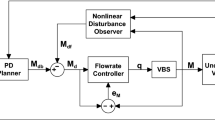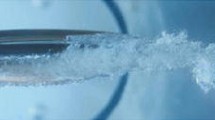Abstract
A two-stage model-independent hovering control scheme for underwater vehicles, which are subject to unknown yet constant external disturbance, to eliminate steady-state depth error is proposed. Proportional-derivative (PD) state feedback control law is adopted as the ballast mass planner at the first stage for the vehicle to reach both hydrostatic balance and a steady depth. The residual depth error is then removed by an additional disturbance rejection control at the second stage. Global asymptotic stability of the whole system is guaranteed via Lyapunov approach. The effectiveness of the proposed scheme is illustrated by the simulation of diving control of an underwater vehicle with hydraulic variable ballast system.
Similar content being viewed by others
References
YUH J, WEST M. Underwater robotics [J]. Advanced Robotics, 2001, 15(5): 609–639.
GILMOUR B, NICCUM G, O’DONNELL T. Field resident AUV systems—Chevron’s long-term goal for AUV development [C]//2012 IEEE/OES Autonomous Underwater Vehicles (AUV). Southampton, UK: IEEE, 2012: 1–5.
RIDAO P, CARRERAS M, RIBAS D, et al. Intervention AUVs: The next challenge [J]. Annual Reviews in Control, 2015, 40: 227–241.
FONT R, GARCÍA-PELÁEZ J. On a submarine hovering system based on blowing and venting of ballast tanks [J]. Ocean Engineering, 2013, 72: 441–447.
FOSSEN T I. Handbook of marine craft hydrodynamics and motion control [M]. Chichester, UK: John Wiley & Sons, 2011.
LICÉAGA-CASTRO E, LICÉAGA-CASTRO J, UGALDE-LOO C E, et al. Efficient multivariable submarine depth-control system design [J]. Ocean Engineering, 2008, 35(17/18): 1747–1758.
FURLONG M E, PAXTON D, STEVENSON P, et al. Autosub Long Range: A long range deep diving AUV for ocean monitoring [C]//2012 IEEE/OES Autonomous Underwater Vehicles (AUV). Southampton, UK: IEEE, 2012: 1–7.
STEENSON L V, TURNOCK S R, PHILLIPS A B, et al. Model predictive control of a hybrid autonomous underwater vehicle with experimental verification [J]. Proceedings of the Institution of Mechanical Engineers, Part M: Journal of Engineering for the Maritime Environment, 2014, 228(2): 166–179.
WANG L. Model predictive control system design and implementation using MATLAB® [M]. London: Springer London, 2009.
FOSSEN T I, FOSS B A. Sliding control of MIMO nonlinear systems [J]. Modeling, Identification and Control, 1991, 12(3): 129–138.
LIU W, FENG Z, BI A. A novel nonsingular terminal sliding mode control combined with global sliding surface for uncertain nonlinear second-order systems [J]. Transactions of the Institute of Measurement and Control, 2020, 42(7): 1294–1300.
QIAN Y, FENG Z P, BI A Y, et al. T-S fuzzy model-based depth control of underwater vehicles [J]. Journal of Shanghai Jiao Tong University (Science), 2020, 25(3): 315–324.
BI A, FENG Z. Hierarchical control of underwater vehicle variable ballast systems [C]//2018 37th Chinese Control Conference (CCC). Wuhan, China: IEEE, 2018: 3911–3914.
TANGIRALA S, DZIELSKI J. A variable buoyancy control system for a large AUV [J]. IEEE Journal of Oceanic Engineering, 2007, 32(4): 762–771.
WOODS S A, BAUER R J, SETO M L. Automated ballast tank control system for autonomous underwater vehicles [J]. IEEE Journal of Oceanic Engineering, 2012, 37(4): 727–739.
JIN S, KIM J, KIM J, et al. Six-degree-of-freedom hovering control of an underwater robotic platform with four tilting thrusters via selective switching control [J]. IEEE/ASME Transactions on Mechatronics, 2015, 20(5): 2370–2378.
MEDVEDEV A V, KOSTENKO V V, TOLSTONOGOV A Y. Depth control methods of variable buoyancy AUV [C]//2017 IEEE Underwater Technology (UT). Busan, Korea: IEEE, 2017: 1–5.
TANAKITKORN K, WILSON P A, TURNOCK S R, et al. Depth control for an over-actuated, hover-capable autonomous underwater vehicle with experimental verification [J]. Mechatronics, 2017, 41: 67–81.
HUANG H T, ZHOU J Y, DI Q, et al. Three-dimensional trajectory tracking control of underactuateed autonomous underwater vehides with input saturation [J]. Journal of Shanghai Jiao Tong University (Science), 2020, 25(4): 470–477.
PYO J, CHO H, JOE H, et al. Development of hovering type AUV “Cyclops” and its performance evaluation using image mosaicing [J]. Ocean Engineering, 2015, 109: 517–530.
MCFARLAND D, GILHESPY I, HONARY E. DIVEBOT: A diving robot with a whale-like buoyancy mechanism [J]. Robotica, 2003, 21(4): 385–398.
VASILESCU I, DETWEILER C, DONIEC M, et al. AMOUR V: A hovering energy efficient underwater robot capable of dynamic payloads [J]. The International Journal of Robotics Research, 2010, 29(5): 547–570.
LIU Y, ZHAO X, WU D, et al. Study on the control methods of a water hydraulic variable ballast system for submersible vehicles [J]. Ocean Engineering, 2015, 108: 648–661.
ZHAO X, LIU Y, HAN M, et al. Improving the performance of an AUV hovering system by introducing low-cost flow rate control into water hydraulic variable ballast system [J]. Ocean Engineering, 2016, 125: 155–169.
GUO B Z, ZHAO Z L. Active disturbance rejection control for nonlinear systems [M]. Singapore: John Wiley & Sons, 2016.
ZHENG T H, FENG Z P, ZHAO S, et al. Active disturbance rejection controller based heading control of underwater flight vehicles [J]. Journal of Shanghai Jiao Tong University (Science), 2020, 25(4): 441–446.
Author information
Authors and Affiliations
Corresponding author
Rights and permissions
About this article
Cite this article
Bi, A., Feng, Z., Zhu, Y. et al. Two-Stage Scheme for Disturbance Rejection Hovering Control of Underwater Vehicles. J. Shanghai Jiaotong Univ. (Sci.) 27, 375–382 (2022). https://doi.org/10.1007/s12204-021-2341-1
Received:
Accepted:
Published:
Issue Date:
DOI: https://doi.org/10.1007/s12204-021-2341-1




